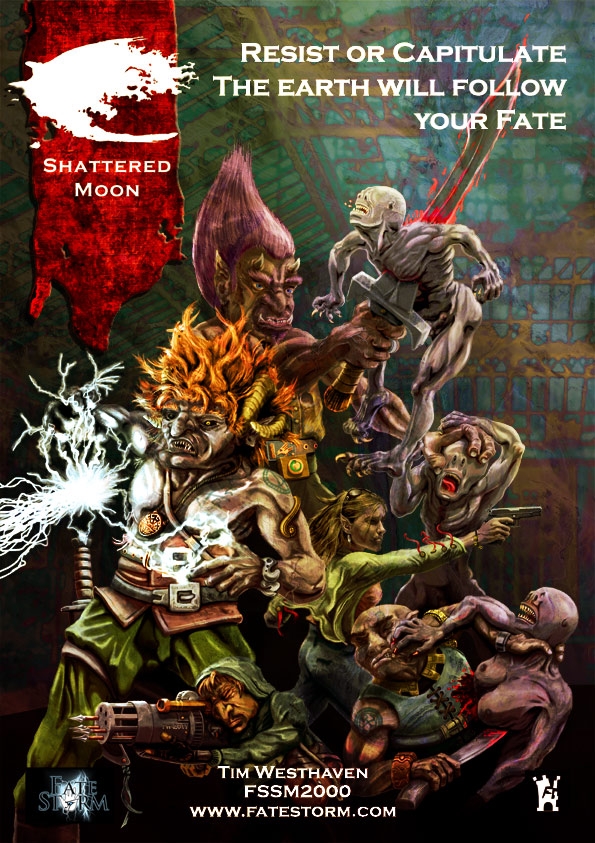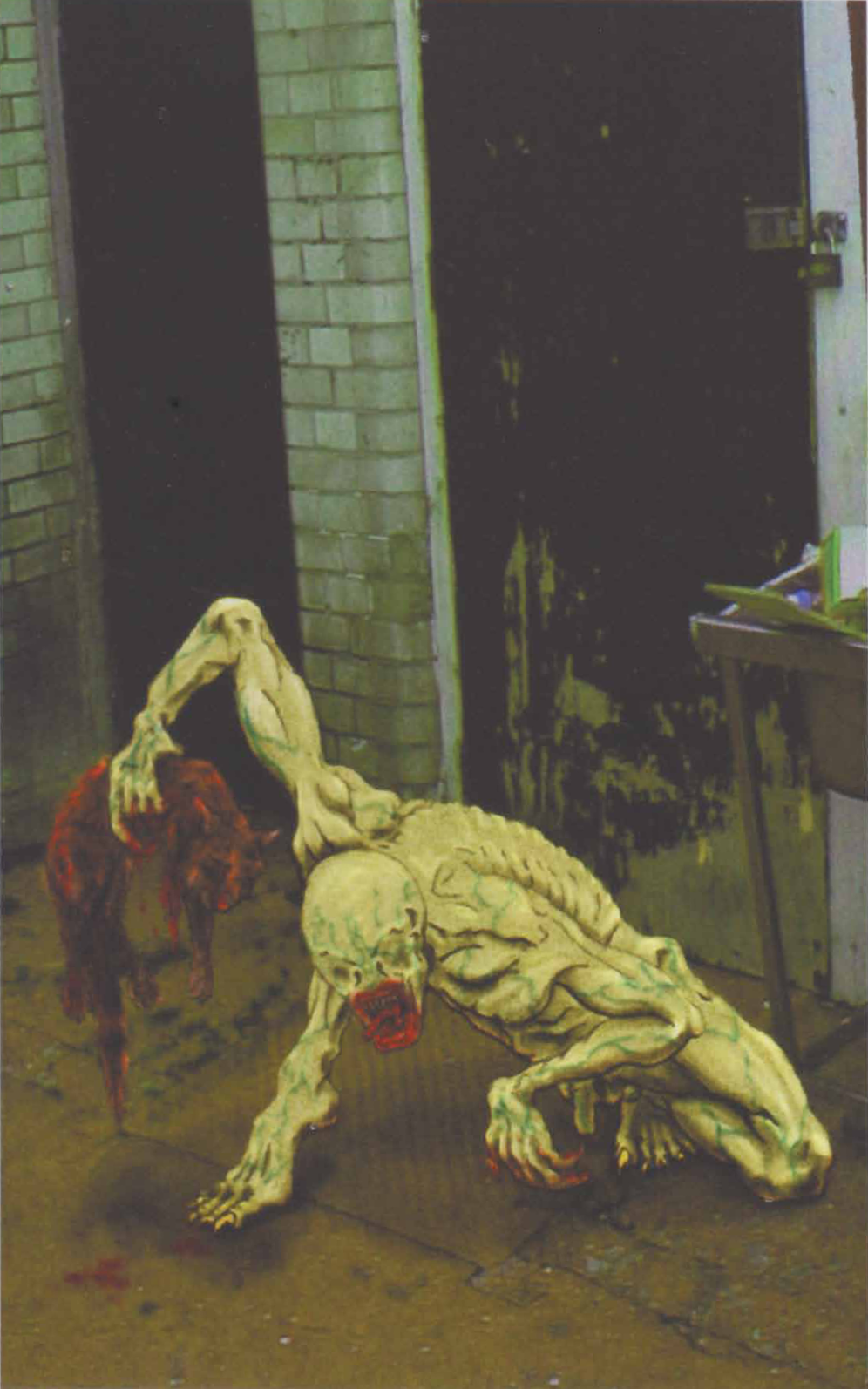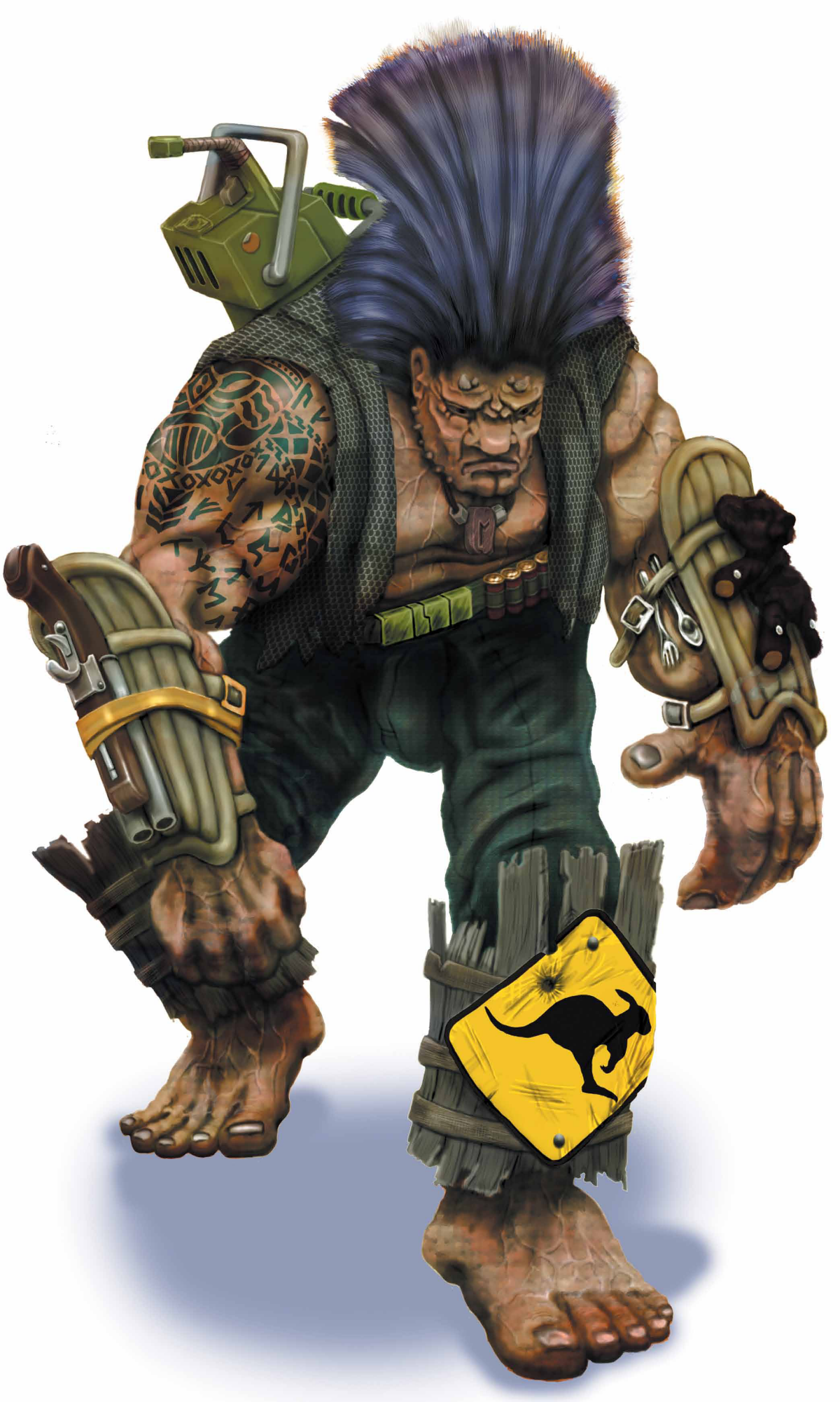
Download Shattered Moon
Shattered Moon is a roleplaying game from Broken Tower and Tim Westhaven. Westhaven is both author and artist on the game, given that the book is 320 pages of colourful art and clever text the project must have been a labour of love.
Shattered Moon makes use of the FateStorm VRS. That’s the FateStorm Virtual Reality System. It’s entirely wrong to try and classify FateStorm as some sort of wishy-washy hand-wavy structured storytelling guidelines. Shattered Moon includes rules for miniatures, tactical combat and has a four page glossary early on just to describe all the abbreviations and system terms. This is a proper system.
So why the disclaimer? As Westhaven acknowledges FateStorm uses no dice and that may unsettle some gamers. The principle is that in Shattered Moon the GM (known as Fate) make decisions made on evidence of the character (known as Avatar) and their abilities, skills, magic and roleplay. In a section called “Dice Withdrawal” we learn how the system is designed to allow the same tense of tension and adventure. There are cards from the FateDeck (provided, in colour, to print at the back of the PDF) when the Fate needs either inspiration.
I do not find the lack of dice worrying. As a gamer I’m pretty system neutral; preferring abstraction and swiftness most of the time rather than charts and tables. FateStorm is somewhere in the middle on the scale. That said; this is not a playtest review of Shattered Moon because I couldn’t satisfactory run through the system solo and an attempt to do a quick scene with a visiting friend ran out of time due to our mutual lack of familiarity with the system. As noted; FateStorm VRS isn’t light on the rules, it’s a well thought out and fully fleshed system – just without dice.
The best thing about Shattered Moon is the setting.
There’s a disclaimer at the start of the book urging player discretion and suggesting Shattered Moon is not for younger audiences. Broken Tower do not condone or look to normalise the crimes of rape, genocide, slavery or cannibalism.
In the post supernatural apocalypse setting of Shattered Moon all of the above crimes happen. A key set of monsters, the Lilim, are described early on and are as likely to rape their victims as they are to eat them and perhaps do both at once.
The moon shattered. Imagine all the ecological and environmental devastation that would cause and you are a third of the way to the wrecked world that the characters (the avatars) will have to try and survive.
The moon was a prison. It held Lilith, the Dark Lady, a God and when it shattered she escaped. Lilith was not alone. The Nephilim, the first beings on earth, worked with Lilith even before the titan war and were imprisoned with her in punishment for that alliance. The seven Nephilim have also returned, landing on Earth with their giant crystal cathedrals and the Cthulhu like tentacled beasts appear to have no physical weakness. All attempts to injure one have failed.
 It is from these Cathedrals that the dangerous Lilim flood out from to terrorise the world. In a nice touch, the layout of Shattered Moon includes snippets of newspaper clippings from the early post-shattered world, before everything fell apart, of mankind wondering whether it was some sort of virus, radiation or mutation responsible for these humanoid but eyeless horrors.
It is from these Cathedrals that the dangerous Lilim flood out from to terrorise the world. In a nice touch, the layout of Shattered Moon includes snippets of newspaper clippings from the early post-shattered world, before everything fell apart, of mankind wondering whether it was some sort of virus, radiation or mutation responsible for these humanoid but eyeless horrors.
With the shattering of the moon, the magical seal, magic returned to the land. When Oberon’s Seal broke the supernatural barrier that blocked the Warp from manifesting on the earth was gone.
Some animals and plants transformed into creatures and monsters with the return of magic. Some humans, people who possessed ancient souls of Sidhe, found themselves transforming into something else.
In Shattered Moon players take on the role of one of these new Sidhe – the nuoSidhe. They can be dwarves, elves, goblins, ogres or trolls. Each has their own unique abilities and may belong to either the seelie or unseelie courts.
The unseelie courts have sided with Lilith to conquer the world. The seelie courts have not but that does not mean the remains of mankind, dregs of the surviving armies, the new armed and dangerous territories that have risen treat the seelie any differently from the unseelie. Both courts are feared, hunted and mistrusted.
The FateStorm system is heavily interwoven with the roleplaying levers in Shattered Moon. The Sidhe have characteristics (greedy, malediction, stylish, etc) measured by points. These totals influence the characters directly in terms of which courts they may belong to and that has connections to powers.
The nuoSidhe care greatly about their hoard and tithes. Tithes are the cost of their powers and hoards reflect the nuoSidhe’s court and limit of their power. This means the nuoSidhe naturally act up to certain stereotypes because they need to pay these tithes and collect their hoards. As if the way with FateStorm these numbers are plugged into the mechanics too. For example, an increase in hoard rating will automatically increase the rating in the corresponding court personality by 1.
Shattered Moon finds room for monsters, character vocations with their associated unique abilities, over 100 weaves (spells), monsters as well as a world map and a tour of the remains of the planet. There are weapons and armour along with the rules for resolving combat (down to tactics like grappling, stuns, pain and secondary damage).
The character sheets are gorgeous. Shattered Moon explains about the warp, the spheres of existence, the Soluus, rhw chords of existence and a whole background to the magic and mythology of the world. The “maps”, if you can call them that, that illustrate these energies and connections also act as the structured background to the character sheets. GMs (Fates) will probably need to explain some of that background when players see the character sheets or be prepared to be mysterious.
I like the concept of the FateStorm VRS. I just want to play it through a few times before I’ll underwrite that confidence with a double thumbs up. I understood it all on the first read which is a good sign, have read parts of it a good few more times since and everything holds together.
FateStorm, I think, is a great system for Shattered Moon. That should be no surprise.
Crucially, I really like the Shattered Moon setting. I know have the urge to game in a really dark fairy tale of a post-apocalyptic world. Despite the great powers that underpin the mythology in Shattered Moon I think it’s the day to day struggle that will be the game’s greatest storytelling asset. The juxtaposition of the horrors from the demonic like Lilum to the dream like nuoSidhe courts is compelling.
A read through Shattered Moon generates the “play this now” urge. I recognise that feeling from some of my favourite games.
You can buy Shattered Moon from DriveThru RPG.


